Urban History
Warren Murfitt reclaims Vancouver’s heritage through his Fircaster guitars
By Brian Lynch / Photographs by Rebecca Blissett / Originally Published in Fretboard Journal, June 2020
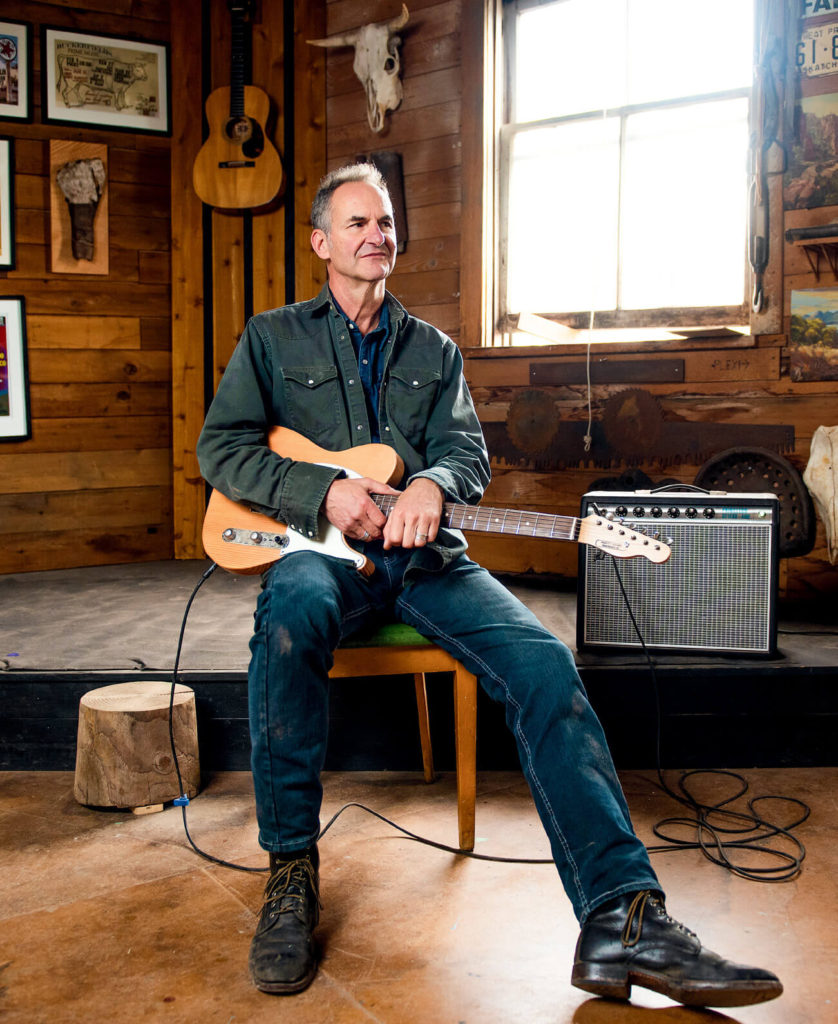
Guitarmaker and musician Warren Murfitt in his Vancouver, British Columbia, workshop.
When luthier and musician Warren Murfitt sought inspiration for a distinctive new line of electric guitars, he only had to look to the heavens. Or rather, to the rafters of his large upper-floor workshop, located in one of the last ungentrified pockets of urban Vancouver, Canada. There was history in those joists and beams, of a kind that was—and still is—rapidly being erased from the city outside his windows. And he was willing to bet he could get that history to sing.
Murfitt has occupied the spacious, well-equipped studio for almost 30 years now, and the sound of drills and saws that regularly spills out of it is in tune with the heritage of the neighborhood. The two-story building that houses the shop sits in a cluster of similarly scuffed remnants of an industrial boom that swept over this West Coast city a century ago, ignited by the region’s wealth of lumber, minerals and fish. Nearby are brick-clad structures built in the 1920s as foundries, machine shops, farm-equipment showrooms—even, in one case, as the headquarters of a long-since-vanished company that designed and built the intricate neon signs that once famously lined Vancouver’s main streets.
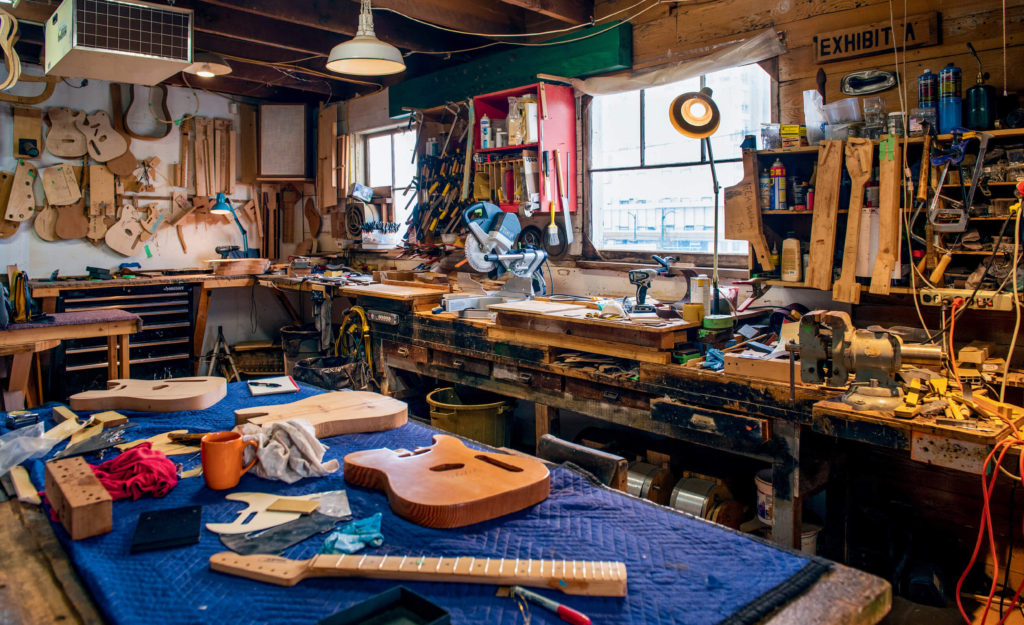
Modern-day Vancouver, British Columbia, doesn’t have many spaces left that lend themselves to old school woodworking operations. Murfitt stumbled upon his perfect, light-filled building three decades ago and, somehow, it hasn’t been developed…yet.
Murfitt’s building had its own role in this old industrial nexus, which stood between sprawling railyards to the east and, to the west, the docks, sawmills, warehouses and cooperages that lined the water’s edge at the time.
“It was built by the Buckerfield family,” Murfitt recounts over a beer as evening sunlight streams into the shop. “They were from Vancouver and sold garden supplies and seeds, and this was a warehouse. So when I took over this space, there were seeds and signs here.”
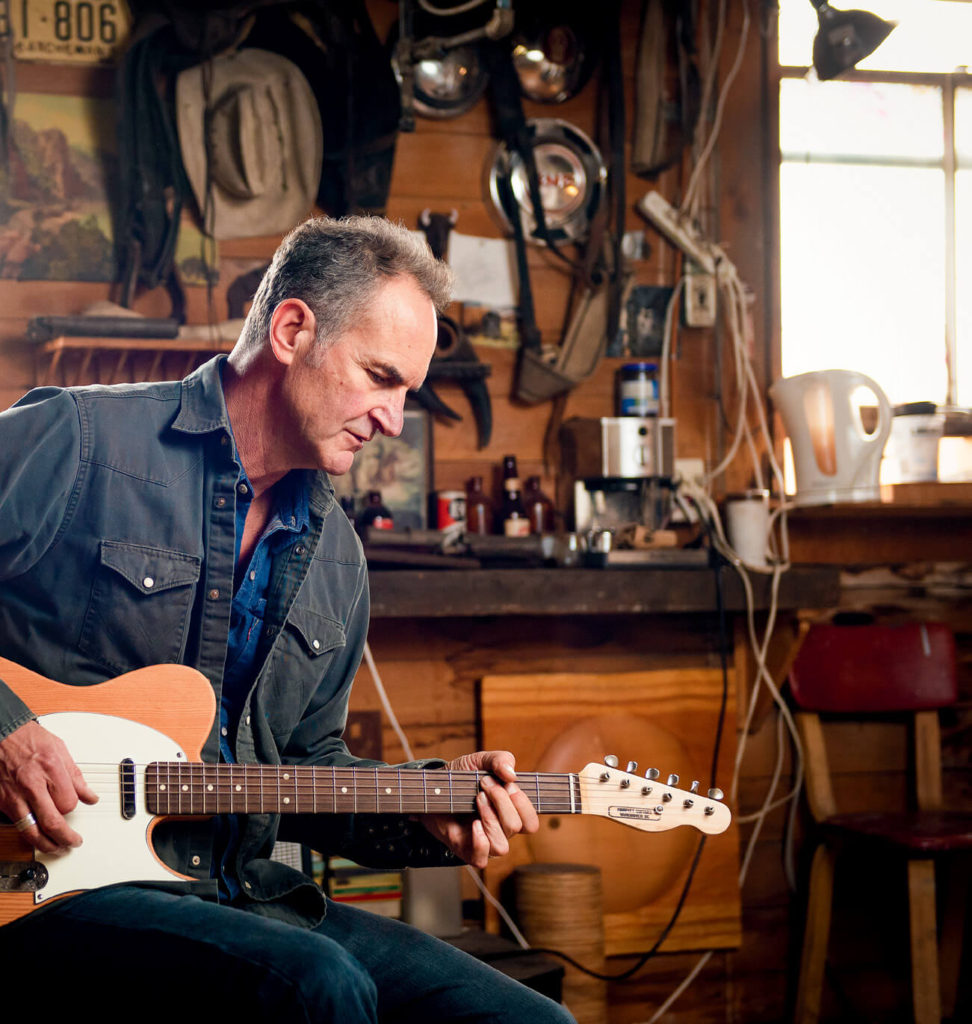
Though plenty know him for his acoustic guitar creations, Murfitt’s current focus is on his Telecaster-style guitars. His wood supplier is a short commute away: He harvests old growth Douglas fir directly from his building’s excess rafters and beams.
Since Murfitt’s arrival in the early 1990s, the surroundings have changed in ways that would astonish those early tenants. Hyperactive development has reshaped many cities in North America, but few places have witnessed the wholesale physical transformation that Vancouver has undergone in a matter of years, as part of its shift from edge-dwelling resource town to lifestyle mecca and tech hub. In little more than a decade, the low-slung industrial buildings that once stood between Murfitt’s shop and the waterfront have been replaced by gleaming, densely packed condo towers. The line dividing old from new is now only a couple of hundred yards away, on the far side of a main road.
“It really makes me upset,” Murfitt says of the city’s apparent eagerness to bury its own past. “I hate seeing a plaque announcing where something used to be. It’s kind of a tear down culture.”
These pressures give his love of reclaimed timber an added sense of urgency, as if Murfitt is reshaping Vancouver’s fading built heritage in his own way. Wood that he’s salvaged from local demolition and renovation sites has been a crucial ingredient in his practice from its earliest days, when Murfitt established himself as a cabinet-maker and furniture-builder. It was only a matter of time before these elements collided and merged with his lifelong passion for country and folk music, which had carried him through his studies at art school in Vancouver, and which shows up plainly in a list of creative influences he once formulated: “Brancusi, George Jones and the Bauhaus.”
“I learned how to cast bronze and carve wood, and how to do this, that and the other thing, and I was good at sculpture,” he recalls of his student days. “I know my way around the art world, but it wasn’t a world that really interested me that much. And when I hit the music world and the guitar world, it just exploded for me.”
By the early 2000s, he explains, he was in full pursuit of a decades-old desire to build the kind of acoustic instruments he loved playing so much.
“I never really was satisfied with building furniture as an art form, because I don’t really care what people sit on,” Murfitt notes with a chuckle, “but I do care what people play, and I do care about sound. I was obviously way more attracted to music. So using that knowledge of material, the musicality of material—that’s what I brought into my guitar business.”
The stars had aligned in favor of the project. Murfitt’s willingness to learn by painstaking experiment was fueled by the shared guitar-building knowledge that had begun to spread online. And at the source was the region’s supply of top-notch materials.
“I got into the wood…and we live in a great place for tonewood,”he says,pointing out the prevalence of such varieties as Sitka spruce, red cedar and figured bigleaf maple. “We’ve got the best wood in the world here in British Columbia.”
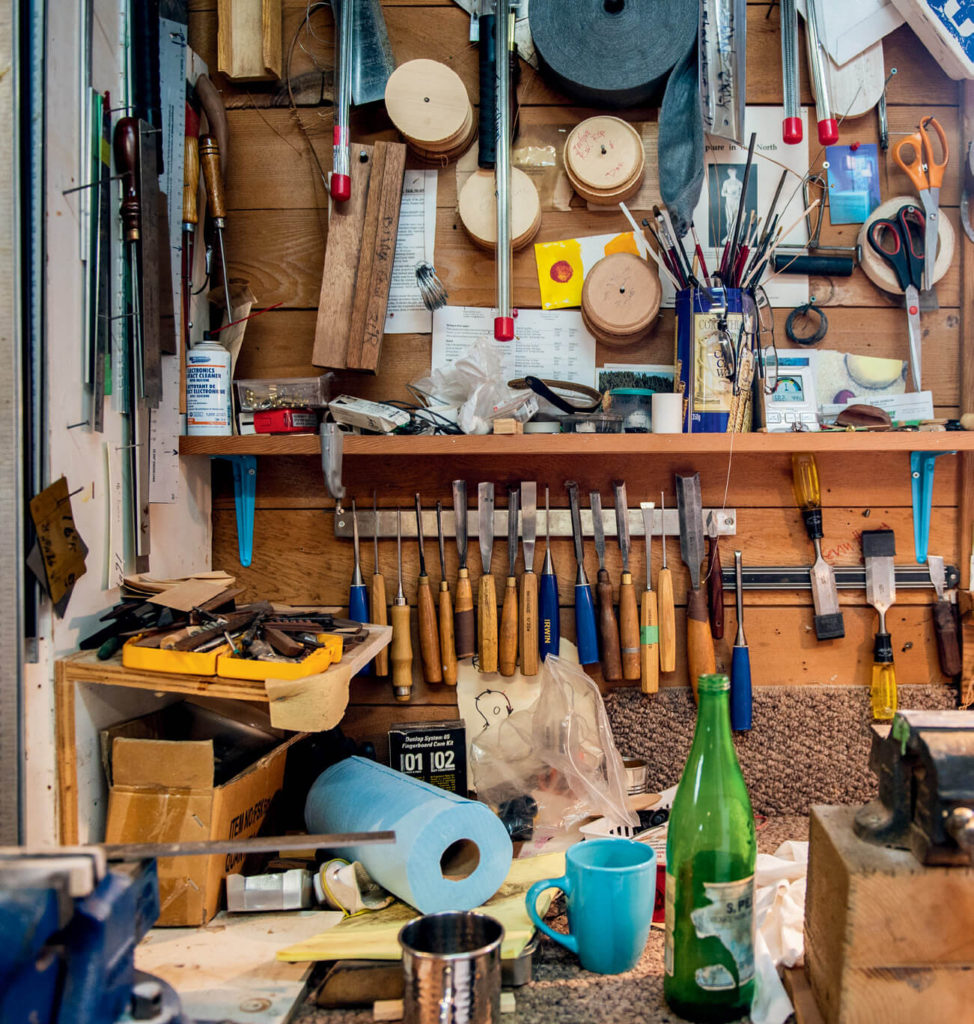
Murfitt’s decidedly old school workbench.
As a self-declared “minimalist by nature,” his steelstring acoustic designs were—and are—starkly timeless: no blingy inlay work, not a cutaway in sight. “My guitars are really plain, and I have a lot of respect for the masters,” he remarks, invoking names like Martin and Gibson. “Those real basic master guitars—I just love them. The great ones are putting the right combinations of wood together, built light and built right.”
So when, a few years ago, his ambitions as a builder began turning electric, classic contours remained the order of the day—most notably, the earliest solidbody designs of Leo Fender. But these lines would conceal Murfitt’s departure from tradition.
He had none of the standard ash, alder or pine on hand. Indeed, as he points out, British Columbia’s Jack pine “is like shit pine. It grows in 40 years and it’s super soft.”
But another promising material was, quite literally, all around him, and it went to the heart of the city’s distant past. “If you look around this building, it’s made out of Douglas fir timber, which was probably milled down here and hauled up the hill,” Murfitt notes.
“So the wood is ancient—it’s 1,500-year-old Douglas fir tree, and it’s been in this building for a hundred years…I mean, look at it: the whole building is lined with Douglas fir. Everything about it is fir. It’s a huge old building and all made out of wood.”
He points up to the thick, richly hued rafters of the workshop. “The timber in the ceiling joists of this building was really big,” he says. “And they’re actually book-matched. They’re out of the same tree. I could show you where the knots all line up. It blows my mind.”
So if you took all the joists down and stacked them together in order? “You could get a tree,” Murfitt observes with a laugh.
He’d worked with reclaimed Douglas fir back when he was building furniture, and found it hard, durable and, with its deep glow, beautiful. How it would perform as a tonewood remained an open question until, giving in to temptation, he climbed to the rafters with his eye on long surplus stretches of timber there. “They were five-foot pieces that were just running wild into the building,” he says, “so I just nipped those off with a saw.”
With a stock of cuts easily large enough to make single-piece bodies—“big timber, one solid body, no glue join”— Murfitt began fashioning prototypes of what he’d eventually dub the Fircaster. He quickly recognized the strengths of the wood.
“The grain is super tight, and it’s comparable in structure to a piece of Sitka spruce,” he says. “It’s really comparable in structure, in the light and the dark, the grain and the hollows.”
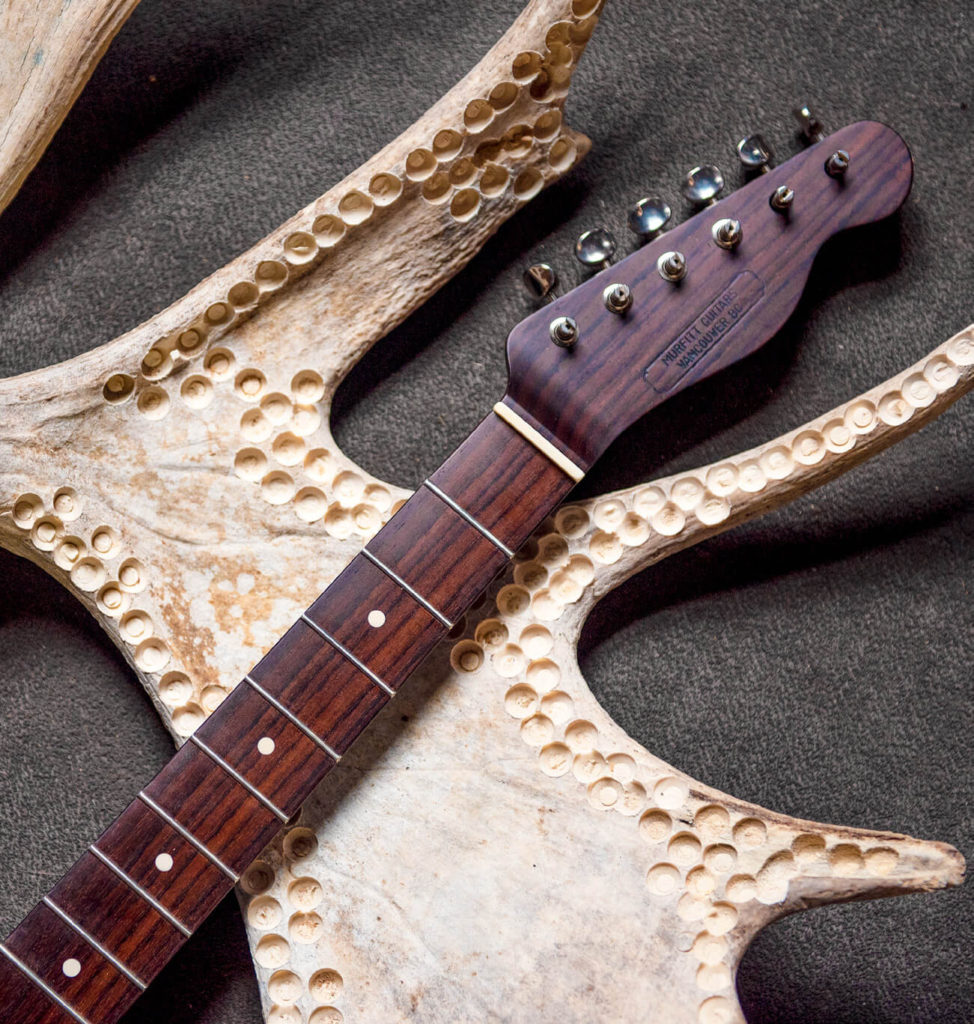
No plastic here: The fret markers from Murfitt’s Fircaster guitar come straight from an old moose antler.
Of course, he always knew that it couldn’t compete with Sitka as a material for tops on his acoustic guitars. But to his hand and ear, it was certainly similar to the kinds of pine often used to build solid body electrics. “When I took a piece of Douglas fir and did a tap test on it, on a slab, it just sounded good,” Murfitt recalls. “It had a ring to it.”
His next detour in design was to chamber the bodies according to a template he gradually refined with the goal of widening tone and reducing weight. This is still a singular part of the Fircaster build process. After slicing a thin layer off the top of a fir billet and setting that layer aside to be later glued on and bound as a grain-matched cap, Murfitt routs the remaining piece along a pattern that leaves wood underneath the bridge and around the neck joint, as well as in a solid stretch down the middle of the body—although he will sometimes slice into parts of that if he feels the item on the bench warrants it.
“I take out as much wood as I feel I’m comfortable with taking out of that particular piece of wood, in order to keep the integrity of the guitar,” he explains. “That subverts the guitar right there. It turns it into a different beast.”
And it makes each beast distinct from its kin, a nature reinforced by the wide variety of necks he likes to pair with the bodies. One guitar features a neck carved out of decades-old maple planking rescued from a demolished bowling alley. Another sports a neck of solid rosewood, a combination he believes to be especially vibrant.
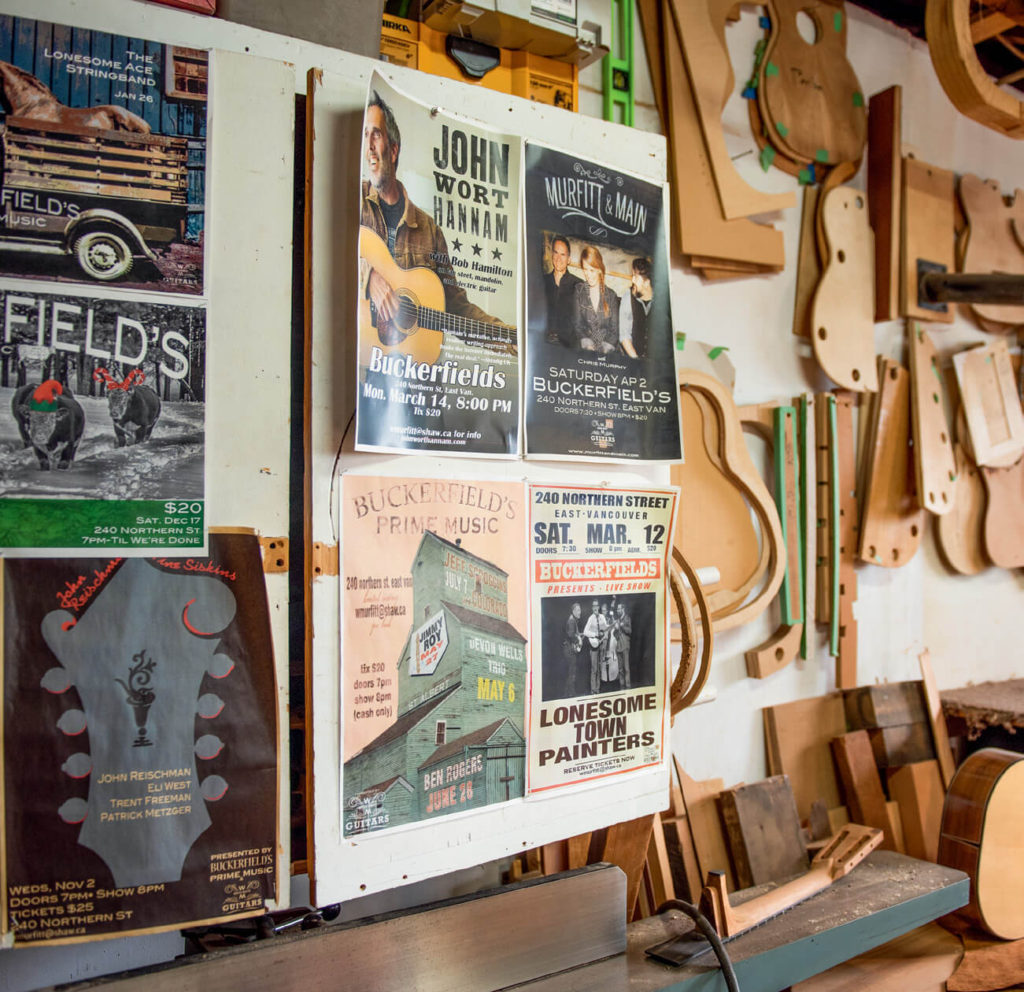
Murfitt’s shop is also one of Vancouver’s most intimate (and interesting) music venues, Buckerfields. Past shows have included Tony Furtado, Andrew Marlin and local mandolin hero John Reischman.
Murfitt has always been quick to place his Fircasters in the hands of electric virtuosos around town, looking for feedback. Most prominent among these has been roots, rockabilly and swing ace Paul Pigat, whom Murfitt regards as a kind of lead consultant on everything from playability to pickguard design. A while back, Pigat even sparked the idea of enhancing the Western Canadian character of the Fircaster by using plugs drilled from the rock-hard edges of moose antler for the markers on dark-wood fretboards. (“It shines up nice and has an essence to it as it wears in,” Murfitt says.)
Tone is Pigat’s specialty, his ear having been tuned by years of recording and gigging with Telecasters of every stripe. He hears something subtly unique resonating in Murfitt’s electric guitars.
“I find that they just have a thicker upper midrange,” Pigat observes on a separate occasion. “They’re just punchier. Like, they have everything else—they have the clarity that you want, they have the big brassy low notes. But there’s just something in the upper mids of the guitar that is a little bit fuller than, say, a standard Telecaster. And I don’t know if it has to do with opening up the body with the chambering, or if it has to do with the wood.”
As with any family of guitars, Pigat is careful not to over-generalize, given how each Fircaster “is distinctly different, being that they’re all handmade.” The individual personality traits, he notes, only deepen with pickup brand, whether Lollar, Fralin, Seymour Duncan, Toronto’s Pickup Wizard or, in the case of Pigat’s own Fircaster, TV Jones.
“They were five-foot pieces that were just running wild into the building, so I just nipped those off with a saw.”
“Mine is considerably more aggressive than, say, most of his other ones,” he says. “Mine’s going to be thicker because my pickups are thicker-sounding. But they all seem to have this midrange quality that’s not as glassy. It’s just a little smoother.”
The gliding twang of George Jones, the Brancusi-like economy of form—perhaps in the Fircaster Murfitt has found a complete expression of the main influences on his own creative history. As for the piece of urban history in which he works, however, time may well be running out. The building that’s home to his studio has been on municipal demolition lists for years now.
“I’ve joined a few different campaigns and gone to the city and lobbied for keeping space within the city for artists to work—artists and craftspeople and workpeople like me who need industrial space,” Murfitt says. “We create a culture within the city that’s interesting and that’s being squeezed out. This is like the forgotten little quarter, because the city owned all of this, and it was at the bottom of their portfolio. So they’re just waiting to develop it.”
But no matter where the towers spread as the city remakes itself once again, he’ll always have some of that history tucked away in cases. He’ll always be able to bring it out, plug it in and hear its echo.